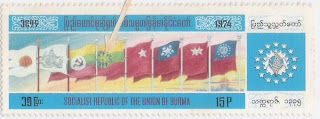Most of my previous posts were devoted to the history and evolution of the Indian National flag under the caption "Quest For a National Flag for India". Since, the series has been completed for the time being, I shall now concentrate on other topics and symbolisms concerning to the National flags of the World.
Most 'National Flags' have symbols and they all have special significance with respect to their country. Symbols on Flags are explicit outward expressions of how the country looks at itself. Let us now glance over such 'Symbols on Flags' as depicted on postage stamps.
BIRDS ON FLAGS
Many countries have placed "Birds" on their National Insignia and flags. Because of the Birds connection to the sky, they have been thought of as a supernatural link between the heavens and the earth. The birds represent a passage between the physical world and spiritual worlds. Birds in flight represent freedom.

The “Double-headed Eagle” devise is inherited from the Byzantine empire. The head on the left (West) symbolizes Rome, the head on the right (East) symbolizes Constantinople. It became widely associated with the Holy Roman Empire. Several Eastern European nations adopted it from the Byzantines and continue to use it as their national symbol to this day, the most prominent being Albania, Austria, Germany, Russia, erstwhile Epirus India’s Mysore State also had a double-headed Eagle the “Gandaberunda” as the royal symbol.


The legendary Gandaberunda possessing two heads facing away from the other was the emblem of the Mysore rulers of the Wadeyar Dynasty.
Indian Navy adopted the Gandaberunda as the crest of the ship 'INS Mysore'.
+of+Page+41.jpg) 'Qureish falcon’ of the Egyptian flag was replaced by the ‘Eagle of Saladin’ bearing on its breast a shield with the national colours in 1984. (Eagle - the emblem of Saladin - a 12th. century Sultan and opponent of the Crusaders)
'Qureish falcon’ of the Egyptian flag was replaced by the ‘Eagle of Saladin’ bearing on its breast a shield with the national colours in 1984. (Eagle - the emblem of Saladin - a 12th. century Sultan and opponent of the Crusaders)The flag of Mexico is an Eagle holding a snake in its beak and standing on a prickly pear. The serpent and the Eagle refer to the legendary foundation of Tenochtitlan (Mexico) by the Aztecs combining the two cosmic forces: that of the sun in the eagle and those of the earth in the serpent.

The Condor – a local bird of the Equatorian Andes- opens its wings and with its majesty and energy symbolizes the Fatherland in its effort of self improvement and progress.
The Steppe Eagle or Berkut (Aquila Nipalensis) is a bird of prey. The Steppe Eagle is the national bird of Kazakhstan and can be seen on its National Flag.
The Goshawk (Acor in Portuguese) refers to the Islands of Azores
The Sisserou Parrot (Amazona imperalis) “The Pride of Dominica”, is the National Bird of Dominica. The parrot figures prominently on the Coat of Arms, the National Flag, The Public Seal, The Mace of the House of Assembly and Dominica’s Honours for Meritorious Service to the Country. The Sisserou Parrot is protected and is found only in Dominica.In 1988 the parrot, which was originally facing right was turned to face the left of the flag.
Burma(Myanmar) had once the "Peacock" as their national emblem. According to believes the Peacock heralds spring, birth, new growth, longevity, and love. (Stamps at the top were issued by Burma Independence Army during Japanese Occupation in1943).
The soapstone bird featured on the flag represents a statuette of a bird found at the ruins of Great Zimbabwe. The bird symbolizes the history of Zimbabwe and now is a national symbol. The flag was adopted on April 18, 1980. Zimbabwe gained independence from Britain as Southern Rhodesia in 1965 and then gained independence from Rhodesia as Zimbabwe in 1980.
The Resplendent Quetzal (Paramocrus Mocinno), the brilliant bird found in the cloud forests of Central America, was sacred to the Mayans and figures prominently in their artwork and legends. Today the Quetzal (also spelled Quetzel and Quesal) is the national bird of Guatemala, and name to the Guatemalan currency.
The Flag of Kiribati has on the upper half a gold frigate bird (Fregata minor, in Kiribati te eitei) flying over a gold rising sun (otintaai). The frigate bird (also called 'Man-of-War' birds or Pirate birds) symbolizes command of the sea, power, freedom and Kiribati cultural dance patterns. Kiribati's flag is an armorial banner, a flag having a design corresponding exactly to that of the shield in the coat of arms. The coat of arms dates back to May 1937 when it was granted to the Gilbert and Ellice Islands, as Kiribati and Tuvalu were then known. The shield was incorporated into the center of the fly of a British Blue Ensign as the state ensign of the colony.
The birds-of-paradise are members of the family Paradisaeidae of the order Passeriformes. The majority of species in this family are found on the island of New Guinea and its satellites. The members of this family are perhaps best known for the plumage of the males of most species, in particular highly elongated and elaborate feathers extending from the beak, wings or head. The family is of cultural importance to the inhabitants of Papua New Guinea.
African Balearic Crested Crane (Balearica regulorum) is a bird in the crane family Gruidae. This bird does not migrate. There are two subspecies. The East African Crested Crane is the national bird of Uganda.
*********







+of+Page+41.jpg)







+of+scan0004.jpg)




+of+scan0004.jpg)
+of+Page+40.jpg)





col.gif)

hii
ReplyDeletePanchkula Call Girls
Panchkula Call Girls
Panchkula Call Girls
Panchkula Call Girls
ReplyDeletePanchkula Call Girls
Panchkula Call Girls
Escorts service in Panchkula
Panchkula Call Girls
ReplyDeletePanchkula Call Girls
Panchkula Call Girls
Panchkula Call Girlsts
"Shop Independence Day flag pins!"
ReplyDeleteIndian Flag Brooch